USER’S MANUAL/INSTALLATION GUIDE
![]()
Installation Instructions for InstallShield Version (tjping.zip)
Installation Instructions for WinZip Self Extractor (tjping.exe)
SECTION 4 - UNINSTALLING TJPING
Welcome to the User’s Manual/Installation Guide for Top Jimmy® Software’s TJPing. I think you will find that TJPing’s speed, ease-of-use, and attractive user interface make it an excellent Ping/Lookup/Traceroute utility. In the following pages you will be guided through TJPing’s simple installation and operation instructions.
TJPing is freeware and is distributed "as is". No guarantee is made about the program - use at your own risk. The author will not be liable for any actual or claimed damages arising from its use.
Anybody can use TJPing - it’s freeware. However, you may not modify, translate, reverse engineer, decompile, disassemble (except to the extent applicable laws specifically prohibit such restriction), or create derivative works based on the Software; rent, lease, transfer or otherwise transfer rights to the Software; or remove any proprietary notices or labels on the Software.
Title, ownership rights, and intellectual property rights in and to the Software shall remain in Top Jimmy® Software. The Software is protected by the copyright laws of the United States and international copyright treaties. Title, ownership rights, and intellectual property rights in and to the content accessed through the Software is the property of the applicable content owner and may be protected by applicable copyright or other law. Top Jimmy is a registered trademark of Jim Dunne.
Compatibility and Requirements
TJPing has been tested on:
Win 95/98 - Winsocks v. 1.1, WSock32 v. 2.2/4.1
NT 3.51 - Winsock v. 1.1
NT 4.0 - Winsock v. 2.0
Windows 2000 - Winsock v. 3.10, WSock v.5.00
Windows XP - Winsock v. 3.10.0.103, WSock32 v. 5.1.2600.0
TJPing requires that the file ICMP.DLL be installed in the c:\windows\system or c:\winnt\system32 directory, depending on whether you're running Win 95 or NT. This file is automatically installed by Win 95 and NT 3.5x and 4.0.
What are Ping, Lookup, and Traceroute?
PING: Ping, an acronym for "Packet INternet Groper" (probably originally contrived to match the submariners’ term for a sonar pulse), is a network scheme wherein a computer, given another "host" computer’s Internet Protocol (IP) address, sends an "echo request" packet to the host across the network. If the host can be reached, it is required to send back an echo reply. This is known as "pinging", and can quickly let you know if a host computer can be reached via TCP/IP (Transmission Control Protocol/Internet Protocol), the standard transmission protocol for the Internet.
TRACEROUTE: Given a host’s name or IP address, and using "ping", one can trace the route the IP packets take to get to the host. By setting certain parameters for the ping function, each node, or internet server, along the route can be required to reply back in sequence. This is known as "traceroute", and allows you to watch the torturous routing the Internet subjects your packets to.
LOOKUP: Many IP addresses have a corresponding Domain Name System (DNS) name. While the IP address must be in the form "xxx.xxx.xxx.xxx", where all the "x’s" are numbers, the DNS name can have letters and numbers, such as "www.jim.com". Given an IP addresses, lookup can be used to find the corresponding DNS name, and vice versa.
Installation Instructions for InstallShield Version (tjping.zip)
The files tjping.zip and tjping.exe contain the same TJPing files, TJPing.exe and TJPing.txt. However, tjping.zip uses the InstallShield installation program to provide an attractive, easy-to-use install/uninstall utility. Tjping.exe uses the WinZip Self-Extractor, which is a simple, effective installation program, and is only one-fourth as large as the InstallShield version. Win NT 3.51 users must use tjping.exe. To install TJPing from the tjping.zip file:
1. Open the file tjping.zip (I suggest you use WinZip), and extract the setup files to their own temporary directory.
2. In the temporary directory, open the file Setup.exe. This will start the installation process.
3. Follow the on-screen prompts. You must tell the setup program which directory you want to install the TJPing files to, and specify the name of the TJPing program folder that will be created for you.
4. Once setup exits, you should see the new TJPing program folder open on your desktop. Open the file TJPing.exe – this starts the TJPing program.
Installation Instructions for WinZip Self-Extractor (tjping.exe)
NT 3.51 users and anyone not desiring the InstallShield support that comes with tjping.zip should use the file tjping.exe, which is WinZip Self-Extractor file.
1. Open the file tjping.exe. (There are several ways to do this, the most common is to double-click the file with the mouse pointer). The "WinZip Self-Extractor" dialog box will appear. You don’t need to have WinZip installed on your computer to run the WinZip Self-Extractor.
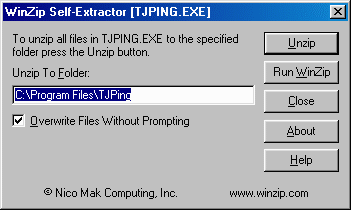
Figure 1 - WinZip Self-Extractor Setup Screen
2. C:\Program Files\TJPing is the default installation directory. If you wish to specify a different installation directory, type it in the "Unzip to Folder" box now.
3. The "Overwrite Files Without Prompting" checkbox is checked by default. If it remains checked, it will overwrite any files in the installation directory that have the same name as the TJPing files (i.e. TJPING.EXE or TJPING.TXT). If you want WinZip Self-Extractor to prompt you before overwriting any files in the installation directory, uncheck this box by clicking your mouse on it one time.
4. Click once on the "Unzip" button. The unzip process will start.
5. When the WinZip Self-Extractor has finished unzipping the files, you will see the following dialog box:
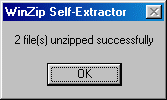
Figure 2 - WinZip SE "OK" dialog box
Click on the "OK" button, then click on the "Close" button on the WinZip Self Extractor dialog box (Figure 1). Installation is now complete.
For those who used the InstallShield program to install TJPing, go to the "Start" button on the lower left-hand corner of your screen. Click this button, and then click "Programs". Find the folder you created for TJPing during installation and click on it. Then click on the TJPing icon in the folder.
Those who used WinZip Self-Extractor to install TJPing should go to the directory where you installed TJPing and open tjping.exe (once again, the most common method of doing this is to double-click on the file with your mouse). Upon starting TJPing, you will see the following screen:
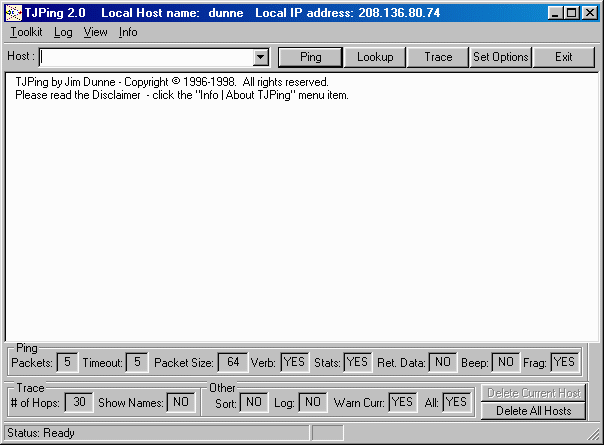
Figure 3 – TJPing main screen
Performing Pings, Lookups, and Traceroutes
To do a ping, lookup, or traceroute, enter an Internet Protocol (IP) address or a Domain Name Service (DNS) name in the "Host:" edit box on the main screen (See Figure 3). An IP address has the format "123.251.011.119", for instance (called "Internet dot notation"), while a DNS name is a string such as "www.anywhere.org". Next, click on the corresponding button or menu item of the operation you want to perform, either the "Ping", "Lookup", or "Trace" button. Figure 4 is a shot of the operations and stop buttons:
![]()
Figure 4 – Operations buttons
The "Toolkit" drop-down menu’s (See Figure 8) options provide the same functionality as the operation buttons. The results of the operation will be displayed in the status window of the main screen. Figure 5 is an example of a ping operation and the results being displayed in the status window.
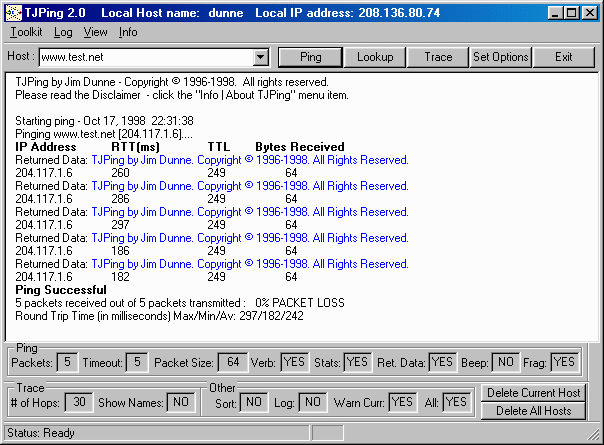
Figure 5 – Ping operation
Upon doing a ping, status information will be shown in the main information window. If the user enters an IP address in the "Hosts:" edit box and begins a ping, TJPing will begin pinging right away. If a DNS name is entered, the status window will show:
Looking up IP address for ‘DNS name’
as TJPing must first find the IP address that corresponds to the DNS name before pinging.
Next, if the user has selected the "Verbose" option, the status window will show:
REQUEST TIMED OUT
if the ping didn’t return before the Timeout period, or will show:
x bytes received from IP address RTT: xms TTL: x
This response shows how many bytes the host returned in response to the ping (should be the same as the number of bytes sent), the Round Trip Time (RTT) in milliseconds, that the packet took in getting to the host and back, and the Time To Live (TTL), which can indicate how many hops the packet took along the way. If at least one of the packets returned successfully, the status window will declare:
Pinged Successfully
If not,
PING UNSUCCESSFULL
will appear.
Next, if the user has checked the "Statistics" option, the line:
x packets received out of x packets transmitted : x% PACKET LOSS
will be shown. This response shows how many packets were sent, how many packets were received in response, and the overall percentage of packets that were lost during that ping operation. Following this line, a line will appear stating:
Round Trip Time (in milliseconds) Max/Min/Av: x/x/xThis line shows the maximum, minimum, and average RTT’s for that ping operation.
Upon starting a Lookup, the main status window will show:
Performing lookup on "IP address/DNS name", please wait...
where IP address/DNS name corresponds to what you have entered in the "Host:" edit box. If the lookup is successful, the status window will show:
Official Name: DNS name
IP address: xxx.xxx.xxx.xxx
The official name is the actual DNS name of the IP address. Some IP addresses have alias DNS names. If so, they will show up below the "IP address" name, like this:
Alias: DNS name
If there is more than one IP address to a DNS name, they will show up in columnar fashion, one after the other. Figure 6 is an example of a lookup operation:
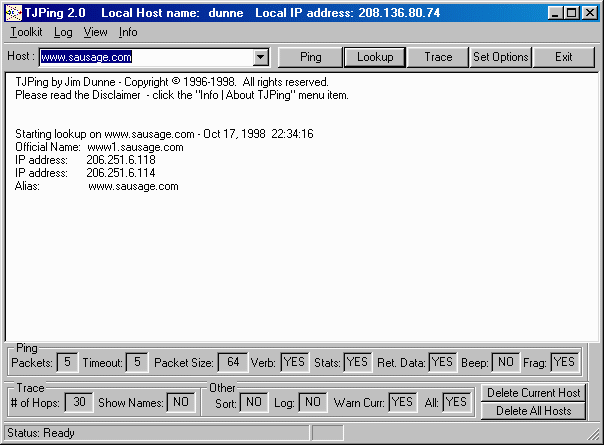
Figure 6 – Lookup operation
If the user enters an IP address in the "Host:" edit box and begins a traceroute, TJPing will begin trying to contact the host right away. If a DNS name is entered, the status window will show:
Looking up IP address for ‘DNS name’
as TJPing must first find the IP address that corresponds to the DNS name before tracing. TJPing then tries to contact the host before starting a traceroute. If a DNS name was entered, the status window will show
Contacting host DNS name[xxx.xxx.xxx.xxx]....
If an IP address was entered:
Contacting host xxx.xxx.xxx.xxx...
shows. Depending on whether or not the host was contacted by the program,
Host contacted
or
Host not contacted
will appear. TJPing will then begin tracing (pinging each host along the route to the desired host). Depending on whether or not the user has checked the "Show DNS Names:" option, either:
Hops IP Address RTT(ms)
or
Hops IP Address RTT(ms) DNS Name
will appear, and the corresponding information for each "Hop" will appear in columnar fashion below this header. If a host doesn’t respond to a ping within the Timeout period,
REQUEST TIMED OUT
Will appear for that hop row. If a ping is successful, and the user has checked "Show DNS names", and the DNS lookup is unsuccessful for that particular host’s IP address,
Hops IP Address RTT(ms) DNS Name
x xxx.xxx.xxx.xxx x HOST LOOKUP FAILED
will appear, indicating that the the DNS lookup on the IP address failed. Figure 7 below is an example of a traceroute operation:
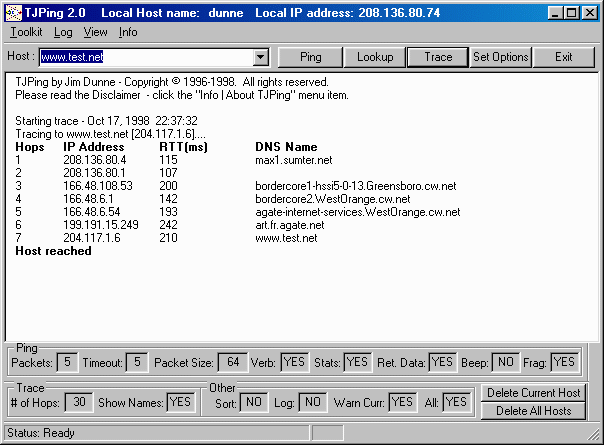
Figure 7 – Traceroute operation
Stopping a Ping, Lookup, or Traceroute
TJPing has the ability to cancel any of the above-mentioned operations. Once pressed, an operation button's text will change to display the word "Stop". Pressing "Stop" will terminate an active operation. In the case of a ping or traceroute, the operation will terminate when it completes its operation on the current packet (i.e., if you press "Stop" when packet 2 out of 10 packets has been sent on a ping, the operation will end when there is a successful response to packet 2, or when that ping times out). Lookups will terminate immediately.
TJPing allows you to set some options for the Ping and Traceroute functions. To access these options, press either the Set Options button on the operations bar, or click the mouse pointer once on the "Set Options" menu item on the top-left of the TJPing window-frame (See Figure 8).
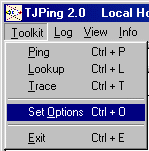
Figure 8 – "Set Options" menu item
When either of these is clicked once with the mouse, the following "TJPing – Set Options" dialog box will appear on your screen:
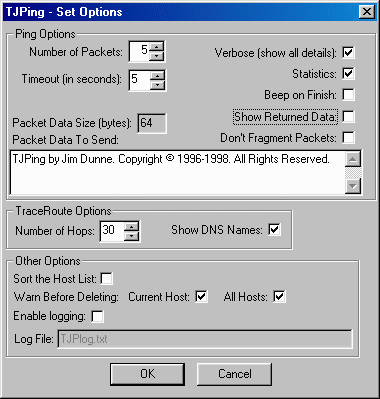
Figure 9 – TJPing "Set Options" dialog box
Number of Packets: This option determines how many times TJPing will ping the specified host in each ping operation. You can change the number of packets by clicking your mouse pointer on the up or down arrows next to the number. The allowed range is 1 – 99 packets. The limit of 99 packets keeps someone from saturating a host with an unlimited number of pings.
Timeout: This is the time, in seconds, that TJPing will wait, once it has sent an echo request to a server, before it continues on with the ping operation or stops pinging, if the specified number of packets has been sent. The allowed range is 1 – 99 seconds. The Timeout value also applies to Traceroute operations.
Packet Size: The number of bytes that will be sent to the host with each ping. The host should respond with an identical number of bytes. This value is taken automatically from the size of the data in the "Packet Data To Send" edit box. You cannot set this value directly.
Packet Data To Send: You can customize the data you want to send on a ping by entering the data here. The data size is limited to 5000 bytes. As you enter or remove data in this box, you will notice that the "Packet Size:" edit box changes automatically to show the size of the data.
Verbose: If checked, this option will display the status of each individual packet sent. The status can either be the number of bytes received from a particular host, or "REQUEST TIMED OUT", which means that the host didn’t respond before the Timeout period elapsed.
Statistics: If checked, TJPing will display the number of packets sent and received, and the percentage of packets that were lost. It will also display the Round Trip Time (RTT) maximum, minimum, and average. The RTT is the time it takes for a packet to complete the round trip from your computer to the host, and back.
Beep On Finish: If selected, TJPing will beep audibly when either a ping or traceroute has completed.
Show Returned Data: If selected, the status window will display the data returned by the host to your computer. It should match the data that was sent out.
Don’t Fragment Packets: This option forces your packets to stay together, no matter how big they are. Normally, if a packet size exceeds the Maximum Transmission Unit (MTU) fragment size, the packet will be fragmented and sent out in pieces – however, this option forces the packets NOT to fragment. If the packet size exceeds the MTU allowed on your computer, the packet will not be sent, and you will get the error message:
ERROR - PACKET MAY NEED TO FRAGMENT - UNCHECK "DON'T FRAGMENT" OPTION
If this happens, you need to either reduce the size of the packets you are trying to send out (usually to less than 1473 bytes), or uncheck this option altogether.
This option is typically only important to network engineers, etc., to test MTU sizes on other hosts.
Number Of Hops: The maximum number of waypoints that TJPing will show before ending a traceroute operation. The default is 30, and the allowed range is 1 to 255.
Show DNS Names: If checked, TJPing will attempt to find and display the DNS name of each server along the traceroute. IP addresses are automatically displayed.
Warn Before Deleting Current Host: If checked, a warning dialog box will appear when the Delete Curr. Host button is pressed. This allows you to cancel the deletion of an individual host entry.
Warn Before Deleting All Hosts: If checked, a warning dialog box will appear when the Delete All Hosts button is pressed. This allows you to cancel the deletion of all host entries.
Enable Logging: If checked, enables logging to the file specified in the Log File: edit box, and activates and allows editing of the Log File: box.
Log File: Specifies the log file to write log entries to. Only editable when the Enable Logging: check box is checked.
Clicking on the "Delete Curr. Host" button will remove the current host from the "Host:" drop-down edit box list and remove it from the Windows Registry. If the "Warn Before Deleting Current Host" option is checked, the dialog box in Figure 10 will appear to confirm that you really want to take this action:
![]()
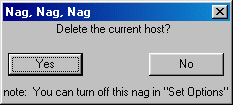
Figure 10 – "Delete Current Host" button and nag box
Clicking on the "Delete All Hosts" button will remove all hosts from the "Host:" drop-down edit box and from the Windows Registry. This button should be used only if users want to permanently clear all hosts from TJPing’s memory. If the "Warn Before Deleting All Hosts" option is checked, the dialog box in Figure 11 will appear to confirm that you really want to take this action:
![]()
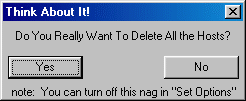
Figure 11 – "Delete All Hosts" button and nag box
TJPing allows results to be logged to a file specified by the user in the "Set Options" dialog box’s "Log File:" edit box (See Figure 9). This box can only be enabled by checking the "Enable logging:" checkbox, or by selecting "Enable" from the "Log" drop-down menu item (Figure 12 below).
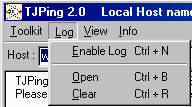
Figure 12 – "Log" drop-down menu
Selecting "Enable" from the drop-down menu, or selecting "Enable logging:" from the "Set Options" dialog box and clicking the "OK" button will enable logging to the file specified in the "Log file:" edit box. All output to TJPing’s status window is logged to this file. Every time logging is enabled, a time/date stamp will be placed at the end of the current log file in this format:
Jul 23, 1997 21:10:42
This stamp gives the user an idea of when he began logging a session, and can also be used to differentiate between different sessions.
When this option is chosen from the "Log" drop-down menu, TJPing will attempt to open the currently specified log file. To do this, TJPing relies on associations between file types and their corresponding default applications to be set up correctly in Windows. For instance, if the log file’s name is the default "TJPlog.txt", when the "Open" option is selected, TJPing will attempt to open the file using the default text-editor, normally Notepad. If no association has been set up, the attempt will fail.
Associations can be set up under the Window’s Explorer "View | Options | File Types" property sheet.
When selected, this option will clear all text from the currently specified log file.
There are several ways to exit TJPing and return to Windows:
1. Go to the Toolkit menu item and click the mouse pointer on the "Exit" option (See the drop-down menu in Figure 8).
2. Click your mouse pointer on the "Exit" button on the operations bar (See Figure 13).
![]()
Figure 13 – Exit button
3. Click your mouse pointer on the "X-it" button on the upper-right of the TJPing screen frame (for Win 95, See Figure 14), or double-click the pointer on the file drawer on the upper-left of the screen frame for Win NT 3.51.
![]()
Figure 14 – Frame "X-it"
To maximize the TJPing window to fit the entire screen, click your mouse pointer on the "Maximize" button on the upper-right of the TJPing screen frame (See Figure 15).
![]()
Figure 15 -– Frame maximize button for Win 95/98
and NT 4.0 (left) and NT 3.51(right)
To minimize the TJPing window to the taskbar, click your mouse pointer on the "Minimize" button on the upper-right of the TJPing screen frame (See Figure 16).
![]()
Figure 16 – Frame minimize buttons for Win 95/98
and NT 4.0 (left) and NT 3.51(right)
You access the "Info" menu item by clicking on it once with your mouse, or pressing the "Alt" key and then the "i" key.
The "Info | About TJPing" menu item
Once you have accessed the "Info" menu item, you access the "Info | About TJPing" menu item by clicking on it once with your mouse or pressing the "A" key.
Figure 17 shows the dialog box you will see:
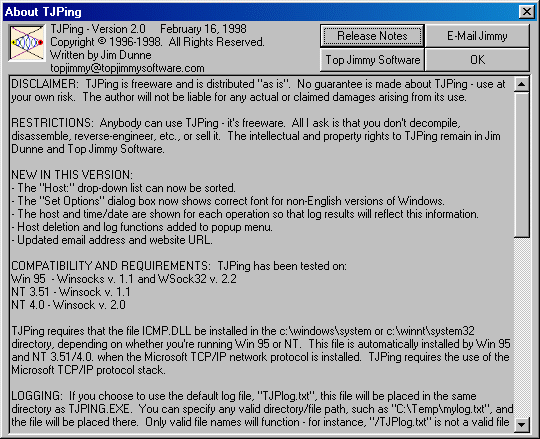
Figure 17 - "About TJPing" dialog box
Use the scroll bar to scroll through the descriptive text in the edit box, which contains information about TJPing.
Pressing the "Release Notes" button starts the default text editor (usually Notepad in Windows, but you may have setup a different default text editor) and opens the TJPing.txt file that resides in the same directory as TJPing.exe. If you don’t have a default text editor registered with your operating system (OS), this button won’t work
Pressing the "Top Jimmy Software" button will make your default web browser open and load the Top Jimmy Software homepage. If you don’t have a default web browser registered with your OS, this button won’t work.
Pressing the "E-Mail Jimmy" button will start your default email program and open a new message with the "To:" field filled in with my email address. If you don’t have a default email program registered with your OS, this button won’t work.
The "Info | About Your Winsock" menu item
This menu item displays information about the Winsock installed on your computer. The following is a typical display upon clicking this menu item:
Version: 1.1
Description: Microsoft wsock32.dll, ver2.2, 32bit of Apr 7 1997, at 22:02:49.
System Status: On Win95.
Maximum sockets per process 32767
Maximum datagram packet size: 65467
The "Info | Release Notes" menu item
Performs the same function as the "Release Notes" button on the "About TJPing" dialog box.
The "Info | Top Jimmy Homepage" menu item
Performs the same function as the "Top Jimmy Software" button on the "About TJPing" dialog box.
The "Info | Send an E-Mail to Jimmy" menu item
Performs the same function as the "E-Mail Jimmy" button on the "About TJPing" dialog box.
Accelerator keys are combinations of keystrokes that can perform certain functions. They can be handy if you want to use the keyboard to do certain operations. TJPing uses accelerator keys for three purposes; editing the text in edit boxes, controlling operations such as ping, traceroute, etc., and selecting items from drop-down menus.
Accelerator Keys – Text Editing
Accelerator keys can be used to edit text in TJPing’s main status window, in the "Host:" edit box, and in the edit boxes in the "Set Options" dialog box. The keystroke combinations and their functions follow:
Keystroke Combination |
Function |
Ctrl + C |
Copy |
Ctrl + V |
Paste |
Ctrl + X |
Cut |
Ctrl + U |
Undo |
Figure 18 – Text Editing Accelerator Keys
If you look at the "Toolkit" and "Log" (See Figure 12) drop-down menus, you’ll notice there is an accelerator key combination next to each choice. For example, next to "Log | Enable" is a "Ctrl + N". These are the accelerator keys that perform that function. Holding down the ""Ctrl" key and then pressing the "N" key will enable the logging feature.
Accelerator Keys – Drop- down Menus
In Figure 12 you’ll notice that the "L" in "Log" is underlined. This means that the menu can be accessed by hitting the "Alt" key, then the "L" key. To enable the log, you would hit the "Alt", "L", and "E" keys in succession. Any menu item with an underlined letter can be accessed this way.
Right Mouse Button Functionality
The right mouse button can be used in any edit box in TJPing. When you right-click in one of these boxes, you get a pop-up menu with text editing choices appropriate for the state of the edit box. For instance, if you have text highlighted and right-click, you will get the following pop-up menu:
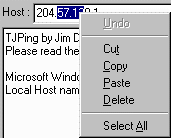
Figure 19 – Pop-up Menu
Note: Using the right mouse button, you can perform the "Undo" function on the "Host:" combobox.
SECTION 4 - UNINSTALLING TJPING
If you used the InstallShield installation program to install TJPing, go to the Control Panel (click on the "Start" button, then on "Settings", and then "Control Panel") , then click on the "Add/Remove Programs" icon. Select TJPing from the list
and then click on the "Add/Remove" button.
If you used the WinZip Self-Extractor installation program to install TJPing, simply delete the directory that you created for TJPing, and the TJPING.EXE and TJPING.TXT and any other files in it.
To remove the registry entries that TJPing creates, open the Registry Editor (regedit.exe), click on the "Edit" menu selection, then "Find", and type in "Top Jimmy Software" in the edit box provided. Click on "Find Next", and the first key found will be \\HKEY_CURRENT_USER\Software\Top Jimmy Software. Delete this key.
Press the "F3" key to continue the search. The next key found will be \\HKEY_LOCAL_MACHINE\SOFTWARE\Top Jimmy Software. Delete this key.
Press the "F3" key to continue the search. The next key found will be \\HKEY_USERS\Default\Software\Top Jimmy Software. Delete this key.
Follow the steps outlined above for the WinZip Self-Extractor uninstallation. The steps for deleting registry entries are the same. Regedt32.exe is the Registry Editor executable in NT 3.51
WARNING! If you are not familiar with the Registry and using the Registry Editor, get someone who is familiar with them to delete these Registry entries for you!! If you make mistakes in editing your Registry, you can make Windows crash and become unusable!!
Question: When I start TJPing, instead of the "Local Host name:" and "Local IP address:" line, I get a message about a Winsock error. What’s going on?
Answer: Upon startup, TJPing tries to start the Winsock services necessary for TJPing to function. This error means that either Winsock is not installed on your computer, or that there is an error with your Winsock installation. Make sure that you have the TCP/IP protocol installed by going to "Control Panel" and "Network" and looking for TCP/IP as one of the installed protocols. If you can’t figure out why you are receiving this error, please consult your System Administrator or Technical Support at your Internet Service Provider for assistance.
Question: When I start TJPing, I get the following Error Dialog Box about ICMP.DLL not being installed.

Figure 20 – ICMP error dialog box
Answer: TJPing requires that the file ICMP.DLL be present in either the C:\Windows\Sytem directory for Windows 95, or the C:\Winnt\System32 directory for Windows NT 3.5x/4.0. Normally, Windows installs this file automatically when you install the TCP/IP protocol. Make sure that you have the TCP/IP protocol installed by going to "Control Panel" and "Network" and looking for TCP/IP as one of the installed protocols. If TCP/IP is installed, and you still don’t have ICMP.DLL, you can download it from the Top Jimmy® Software webpage at:
If your Windows installation resides on a hard drive besides "C:", you will need to put a copy of ICMP.DLL in your TJPing directory in order for TJPing to find it.